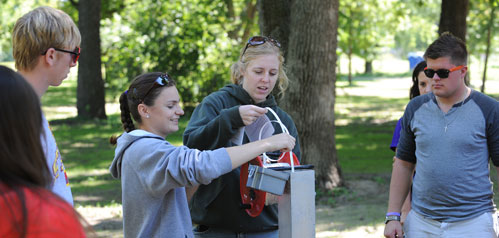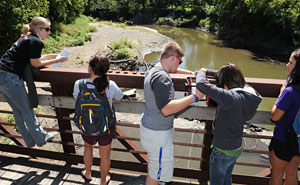Sept. 15, 2011

Graduate students Elizabeth Moss (center) and Madelyn Mette show students how to take water level measurements in a well. Photo by Bob Elbert.
New monitoring wells make up latest ISU teaching lab
by Diana Pounds
Instructors in geology and engineering are pretty pumped about eight wells recently installed near campus. The new 20-foot-deep monitoring wells, east of Hilton Coliseum in Stuart Smith Park, are there to provide richer learning experiences for ISU students studying water science in a variety of classes.
The wells are near the pedestrian bridge over Squaw Creek. The creek, the wells and an assortment of technology combine to form an educational laboratory, where students will collect all kinds of data, analyze water samples, conduct research and get acquainted with advanced water monitoring techniques.
The drive to create an "authentic water field station" for students was mounted by four professors -- Bill Simpkins, Cinzia Cervato and Kristie Franz, all in the geological and atmospheric sciences department, and Chris Rehmann, in the civil, construction and environmental engineering department.
"ISU supports a geologic field station near Shell, Wyo.," Simpkins said. "This water field station is a bit closer to home."
The four professors believe the wells, stream gaging equipment and real-time monitoring capability will be a valuable learning tool for students at all stages of their academic careers.
Geology 100: Basic concepts, real research
Cervato wants to use the wells to teach basic concepts about water movement to introductory classes. Students in her Geology 100 labs also will devise and carry out their own research at the water field station.
"We were looking for an opportunity for students to be involved in authentic research," she said. Water is an ideal subject for study because it's interesting to students and relevant to the Iowa State campus, she added.
"The idea is to have students develop research that's meaningful for them, using the same kind of equipment that professional scientists have."
Upper levels: Reinforcing the basics, advanced concepts, technology
Simpkins, who teaches hydrogeology classes, says the water field station will benefit upper-level students by reinforcing basic concepts while also exposing them to advanced concepts and sophisticated technology. In 300- and 400-level courses, for example, students will use Darcy's Law to estimate how much groundwater comes into or out of Squaw Creek at the park. Then they'll measure stream discharge upstream and downstream of the site to provide an independent estimate of groundwater exchange with the creek. Water samples for chemical analyses will be withdrawn from the wells and used to determine potential influence of land use on water chemistry.
First in the field
Last week, students in Geology 100 labs got their feet wet (figuratively) at the new water field station.
"It was good," said graduate student Elizabeth Moss, who showed the students how to take measurements and analyze water samples. "The students were engaged and interested, and it was a beautiful day."

Geology 100 students take measurements on Squaw Creek. Photo by Bob Elbert.
Moss said she hopes the water field station will spark student enthusiasm about science and research.
"A misconception that most people have about science is that it's just memorization of facts and repetition. Hopefully, students will understand that science requires creativity," she said.
The Geology 100 students, as well as those in Simpkins' hydrogeology and Franz and Rehmann's hydrology classes, will pioneer use of the field station this year. In the future, the site will be used for multiple courses in such areas as geology, civil engineering, environmental science, meteorology and agronomy. The four professors involved in the project anticipate that, eventually, some 1,600 students in 17 classes will make use of the site annually.
Field work, the Internet way
While the site was selected for its easy access for students, some students won't even need to venture into the field to do their field work. That's because four of the new wells soon will be rigged with monitoring equipment that can stream data to the Iowa Environmental Mesonet, a statewide weather data-collecting partnership coordinated by the agronomy department.
Probes in selected wells will record water level, temperature and electrical conductivity continuously and send the data to campus for students to view in real time on the Environmental Mesonet.
"Students will see the water table change with stream stage and also with rainfall and snowmelt, all on their laptops," Simpkins said.
The data will be available not only to ISU students, but the general public as well.
State of the art
Several state-of-the-art technologies will be available to students. One item yet to be purchased is a portable StreamPro acoustic Doppler current profiler (ADCP). The device, which resides in a small boat, provides real-time measurements of stream flow and velocity, as it's pulled across a stream.
It's the latest in water monitoring technology, Simpkins said, and ISU instructors are looking forward to giving students early experience with equipment they'll likely use on the job some day.
Another bit of technology that should be added to the water field station soon is an automated stream gage on Squaw Creek. The stream gage will continuously measure stream level and stream flow, helping students to understand the relationship between groundwater and surface water levels at the site. And in conjunction with an existing stream gage at the nearby Lincoln Way bridge, it will help scientists develop a clearer idea of the quantity of water moving through the water field station.
Funding
Funding for the wells and instrumentation ($35,000) came from the Liberal Arts and Sciences College, the Smith Fund in geological and atmospheric sciences and two grants to encourage student interest in science and technology. The grants are from the Iowa Mathematics and Science Education Partnership and Howard Hughes Medical Institute.
The StreamPro acoustic Doppler current profiler (about $26,000) and an automated stream gage (about $11,000), will be funded by the colleges of Engineering and Liberal Arts and Sciences, respectively.
